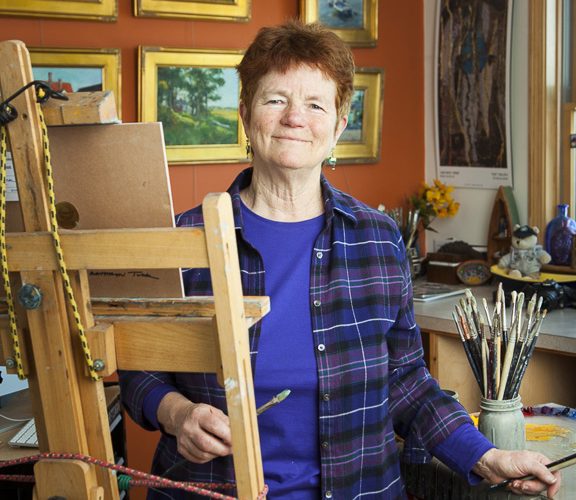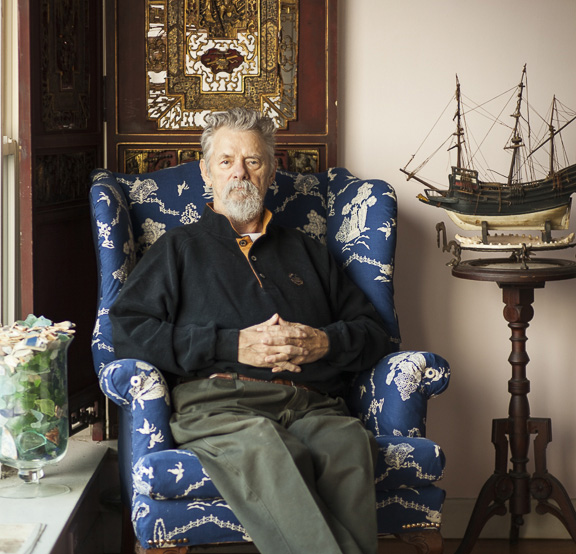As one of the oldest artist colonies in the country, Rockport’s 92-year-old art association paints a fresh face on its future.
For anyone who strolls Rockport’s Main Street, the inevitable discovery of the Rockport Art Association at the crest of its gentle climb is a pleasant surprise. The 1787 yellow clapboard building—once a sea captain’s house—sits unassumingly in the jigsaw streetscape of this postcard-perfect town. Since 1929, when it became the permanent home to the association, it has welcomed some of America’s most renowned painters and sculptors, as well as scores of art patrons from around the world.
Now in its 92nd year, the Rockport Art Association, one of the oldest of its kind in the nation, continues to hold true to its mission to support “Art for Life’s Sake.” New efforts will not only expand its art offerings and programs but also reach out to young, contemporary artists to share its gallery walls.
The association formed in 1921 when a small group of artists decided to create a supportive haven for artists and their patrons. The first location was in the studio of one of its founders, prominent plein air painter Aldro T. Hibbard. Just eight years later, the association moved to its current address at 12 Main Street—the historic Old Tavern Building. The gallery space in this charming two-story building takes up the first and second floors, and includes the old Maddocks Barn Gallery and the new Hibbard Gallery.
Cape Ann’s artists have captured everyday life in the region for more than 100 years. William Lester Stevens, Edward Hopper, Winslow Homer, and Frederick J. Mulhaupt are a few of the internationally known artists to have rendered the area. Additionally, talent like the late Paul Strisik and Rockport Art Association’s first president, Harry Vincent, as well as the remarkable Gruppe family are among the association’s notable members.
Individual styles and subjects on display in the galleries are as diverse as Cape Ann’s topography and its residents’ lifestyles. Their works serve as records of the region’s views over time. The character of the light, the texture of the working harbors, the fishing vessels, and the marsh have delighted artists who have both lived and summered here.
“There was a whole school of art here,” says association member Donald Mosher.“Hibbard, Gruppe, and others who were spin-offs of the American Impressionists, and we attached ourselves to them.” Mosher and his wife, Christine Anne, also an artist, own the Mosher Art Gallery on Main Street. “The light drew us here,” he says, “and the old schooners, the lighthouses, and the rocky shore.”
|
Donald Mosher honors Rockport’s art community with his gallery, Mosher Art Gallery |
Association vice president and artist T.M. Nicholas, whose work is in nume rous museums and private collections, and who has taught painting fr om Hawaii to Tuscany, feels the same. The son of est eemed member artist Tom Nicholas, he has bee n painting since he was a young boy. “I can’t recall wanting to be anything but an artist,” says Nicholas.
“Every area on Cape Ann has a diffe rent light quality,” he adds. “But there is also a variety of moods—sombe r, beautiful, and brutal—and all of the m are fun to capture.” Mosher, Nicholas, and a few other artist members readily acknowledge that sharing their work with the public and inspiring new, young artists to do the same is vital to the future. They know, too, from their own experience, that being involved in the association, whether as a teacher or a volunteer, further ensures that art will hold its place as an integral part of life on Cape Ann.
Rockport Art Association’s current and 29th president and full-time artist, Kathryn Tuck, has been a member since 1986. A Rockport native, she can’t remember a time she didn’t have a brush in her hand. And, like the late painter Harry Vincent, the association’s first president, the landscape remains her focus.
According to Tuck, her parents once ran The Tuck Inn for many years, and made frequent renovations; the drywall scraps became her canvas. She was always on the lookout for artists like Paul Strisik or Tom Nicholas, each of whom gave classes. She’d mount her drywall and quietly paint alongside the rest of the class. “I used to go all over town and spend hours looking in gallery windows of William Flynn, Tom Nicholas, and Betty Lou Schlemm,” says Tuck.
In summarizing the most noteworthy changes she has observed, Tuck points to the gallery’s photography space, which, she says, came with growing pains. It was the result of a major movement in the late 1990s, which broke away from the tradition of painting and sculpture. “The addition of photography has brought a lot of energy and excitement to the exhibits,” she notes.
In recent years, workshops have also brought more community members to the association. Creating awareness has been beneficial. The workshops offer the public the unique opportunity to learn from some of the 250 exhibiting artists. Another newly adopted program that has been well-received is the Artist-in-Residence program. Each month an artist brings a blank canvas to a local school, and by the day’s end, completes a painting. Students watch the work progress and interact with the artist throughout the day.
The hope is that exposing young people to the arts will inspire them, help them discover an undeveloped talent, and perhaps lead toward becoming part of the next generation of artists.To better understand the wants and needs of the community, the board will, for the first time in its history, conduct focus groups to learn what people would like to see offered. At the top of Tuck’s wish list is bringing in a new mix of artists who make contemporary art and lesser-known art forms, like mosaics. Both Tuck and executive director Carol Linsky share the goal of engaging the community’s youth.
One recent program that was particularly successful at spreading the word to the younger generation was “Yesterday, Today, and Tomorrow,” which included three artists. Linsky, a 30-year veteran of the association, sees the value of expanding the art education programs, including the summer programs for children. Attendance for those has continued to grow over the years.
Law Hamilton, an exhibiting photography member since 2001, represents the interests of this art genre to the board of directors. Currently, 55 exhibiting members participate in six annual group shows. Hamilton reinstated opening receptions for the photography shows to encourage more community participation and allow for more dialogue between the public and the artists.
In following the public discussions on whether digital photography is like film, Hamilton works with both, and characterizes the digital form as a new tool. Hamilton notes, “I like a big, wide definition of art. It is the expression. [Art] gets you to stop, see, and comment. When an image communicates what the artist wants, I believe it is art. The language is the same. It is about hues and composition.”
Manchester-by-the-Sea artist and new member, Grace Vasta-Carr agrees: “There’s art for everyone…you need to find what speaks to you. For me, I am attracted to work that has staying power, that changes you, and then changes you more.” A successful artist for the past 28 years and a Cape Ann resident since 1993, Carr is happ y to see the influx of ne w, younger artists and collectors coming to the association. She works in oil and keeps a set of paints tucked into a little cigar box that she totes around for those moments driving along Route 127 when an irresistible scene comes into view. Most of the time though, buds, blooms, and bush of, what she calls, her little backyard Giverny are what end up on her canvas.
As the association heads toward its 100th birthday, we might all do well to unplug from the clicks and pings of technology and take what these artists have so eloquently captured in silence.
As artist T.M. Nicholas says, “Bringing and keeping art in our lives, through places like the Rockport Art Association, gives each of us that breathing time to contemplate, study, covet, and dream.” rockportartassn.com


